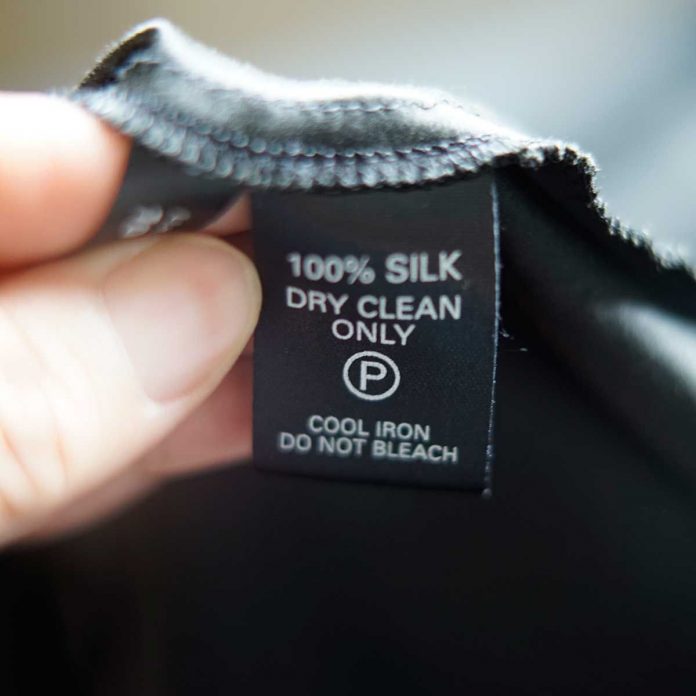When my mother taught me what to look for when buying new clothes, one of the first things she mentioned was to check the label to make sure the garment was not “dry clean only”. She would then add: “No matter how much the price is reduced, the cost of dry cleaning is higher.
But sometimes a gift or thrift store find that couldn’t be dry cleaned would make its way home and we’d have to find a way to wash it ourselves. And of course, we always need to wear it at the last minute, when it’s too late to take it to the dry cleaners. Or maybe you’re going through a pandemic and you’re not supposed to leave the house, but you want to get your laundry pile out of the way and don’t want to wait until you can go out again. Either way, sometimes you’ll need to dry clean something at home. Here’s how to do it.
What does “dry clean only” really mean?
Sure, the label on your blouse may say “dry clean only”, but is there any wiggle room? According to Gwen Whiting, co-founder of The Laundress, there is. “Instructions on care labels are not necessarily the best way to clean an item, but rather a way for manufacturers to avoid liability for irreparable damage when instructions are not followed,” she told Glamour. “When manufacturers don’t follow dry cleaning care instructions, it’s to push the responsibility onto the dry cleaners rather than themselves.”
Similarly, Steve Boorstein, former dry cleaner and founder of ClothingDoctor.com, explains that when a label says ‘dry clean only’, it doesn’t necessarily mean the item can’t be hand washed, especially if it’s made from natural fibres. The ‘dry clean only’ label is there to reduce the risk of people not washing the garment properly at home.
It also depends on the type of garment and fabric. For example, garments of simple construction, unlined and made of natural fibres (cotton, silk and linen) or polyester can probably be washed by hand or in cold water in the machine, according to MarthaStewart.com. On the other hand, suits, pleated skirts and garments made from delicate synthetics, such as rayon, or fabric blends, including silk and wool, should be avoided, as should leather or suede items and those with metallic embellishments, beads or sequins.
Hand washing
One way to wash clothes at home that can only be dry-cleaned is by hand. You can do this in your bathroom or kitchen sink, or in a separate basin. We covered this in detail a few weeks ago, but for the record, here’s what you need to do:
Find yourself a bucket, a sink with the plug or a bathtub with the socket. You will fill this container with water at the temperature you want to wash your clothes.
Use a mild soap or washing powder (not detergent). Dish soap or hair shampoo are good options.
Use your hands or a wooden spoon or something similar to act as a stirrer. Get to work and start churning, mashing and squeezing until everything gets really soapy.
Rinse the items, one by one, in clean water from the nearest container.
Hang the clean clothes to dry on a drying rack, on the curtain rod in your shower, on the backs of chairs or anywhere else you have room.
Using the washing machine
If you really want to use the washing machine, it is possible to safely wash some clothes in it that can only be dry cleaned. There is one major problem, however: the machine must have an “express” setting for this to work. If this is the case, here are Apartment Therapy’s instructions for using your washing machine for dry cleaning only:
1. If the piece is stained, apply stain remover to the affected area while it’s dry.
2. Place your soiled garment in a mesh bag.
3. Use a gentle laundry soap, adding your soap to the detergent dispenser or directly to the drum of your washing machine as directed.
4. Run your washing machine’s express cycle, which agitates your clothes for less time overall.
5. Hang the garment or lay flat to dry.
6. Use a steamer to remove wrinkles if necessary.
Home dry cleaning kits
For some years now, home dry cleaning kits have been available in most supermarkets, pharmacies and supermarkets. If you have one or can get one, that is also a possibility. Basically, these kits work by first treating the stains on the garment and then ‘cleaning’ it by placing a wet pad with the kit’s cleaning solution into your tumble dryer, where the heat vaporises it. While these kits are effective for freshening your clothes, they are not the best for removing oil stains (including body oils).
In fact, it all depends on what you are looking to achieve from the cleaning process. If it’s a family heirloom or other item that shouldn’t be damaged in any way, it’s best to take it to a professional dry cleaner when you have the chance again.










